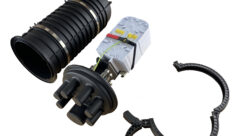Staging Specialists Exploring Fiber Potential
Jul 26, 2006 5:03 PM
In addition to its many applications in educational, judicial, and corporate settings, fiber-based networks and connectivity are finding increasing favor among professional AV contractors who specialize in staged events.
“Fiber is great, for AV staging maybe even more than install,” says Jeff Studley, president of CPR Multimedia Solutions in Gaithersburg, Md. CPR specializes in the kind of one-off, large-scale special events that must bring enormous amounts of high-end audio and video gear together, sometimes in order to be used for a very short time.
In these settings, Studley says, fiber brings a number of big advantages to the table. Rental and staging specialists must load, unload, and transport their gear repeatedly, so weight is always a factor. Moreover, hotel ballrooms, exhibit halls, and other areas that often host special events can be notorious for electrical interference, and these competing signals don’t compromise fiber transmissions.
Studley also points out that more and more staging clients want high-definition video, which greatly increases the amount of data that must be moved around a show site. Fiber can not only transmit high-definition video but also accommodate audio, show control signals, and other data at the same time.
Another advantage fiber brings to staging: Signals can travel farther over fiber without repeaters or reinforcement. CPR Multimedia has often staged events that are very large. “[These events] have massive screens and distant relay screens requiring signal to be sent to stacks of projectors hundreds of feet from videoland,” Studley says.
He adds, “We have rented Telecast fiber systems in the past for some large area outdoor shows where laying copper doesn’t make sense for bulk and ground differential reasons.”
Josh Weisberg, president of Scharff Weisberg, a major staging company based in Long Island City, N.Y., isn’t as sold on fiber as Studley. “We have had a limited inventory of fiber equipment in our staging inventory for a couple of years and use it only for specific HD-SDI transmission applications,” Weisberg says.
While continuing to weigh fiber’s potential in large-scale staging, Weisberg says he’s found Cat-5 cabling a “robust and economical alternative” as a medium for transmitting RGBS video.
A key deterrent to adopting fiber more enthusiastically has been cost, he adds, particularly for the transceiver equipment required to convert DVI signals for optical transmission. “We are currently [seeing] some recent entries into this market,” Weisberg says.
So is Studley. He says CPR Multimedia has been checking out DVI-to-fiber-to-DVI solutions from companies like DVI Gear, Gefen, and Opticomm.
Meanwhile, though, video isn’t the only compelling use for fiber. “Our audio guys are asking about fiber because replacing a 56-channel copper-based snake with fiber would be a huge decrease in weight and bulk, and therefore labor,” says Studley.
“It’s especially nice to use fiber where the snake has to run along the ceiling from front-of-house to stage. We need fewer and lower-rated pick points, lighter-duty rigging gear, and once again, there’s less ground differential issues for the gear at each end.”









